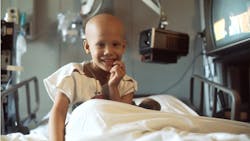Pediatric cancer care and the dental professional
Pediatric cancers are considered rare, yet rates have been rising slightly for the past few decades. According to the American Cancer Society, about 10,500 children in the United States under the age of 15 are expected to be diagnosed with cancer in 2021.1 Advances in treatment options have resulted in 84% of children with cancer now surviving five years or more. Because complications related to childhood cancers and their treatment can last for, or arise, many years after treatments are complete, it’s important for dental professionals to understand the risks and our role in protecting the oral health, quality of life, and safety of our patients who have faced or are currently battling a form of childhood cancer.2
Pediatric cancers are different from cancers affecting adults, even when the tumors occur in the same areas of the body. Children are most often affected by blood and brain cancers and central nervous system (CNS) tumors.3 Short-term and long-term oral side effects experienced can depend on:
- Type and location of the cancer
- Types of treatments
- Age of the child when treated
- Overall systemic health before treatment
- Overall oral health before treatment
- Child’s genetic makeup
According to the article “Significance of oral Candida infections in children with cancer,” children are three times more likely than adults to develop oral complications such as mucositis, xerostomia, bleeding, and infections during cancer treatment.4
Following are the most common treatments that have the greatest effect on oral health:
Chemotherapy
Chemotherapy can induce several side effects, including dry mouth, mouth sores (oral mucositis), and loss of taste and/or taste changes, and an increased risk for tooth decay, infections, and bleeding. These complications can cause pain, compromised nutrition, and potential alterations or delays in treatment. Long-term damage to teeth and gum health can also occur, potentially requiring time-consuming and costly dental care long after cancer treatments are complete, as described below.5
Related reading:
- Risks of medication-related osteonecrosis of the jaw in cancer patients
- The advantages of silver diamine fluoride for cancer patients
- Skin cancer screening: A dental hygienist's life-saving responsibility
While many factors determine which side effects occur with chemotherapy, the level of bacterial burden with dental plaque plays a significant role. Some of the short-term and long-term complications of chemotherapy may be minimized or possibly avoided with a combination of preventive professional dental care, diligent home care, and product selection.
For example, a preventive, hospital-based oral-care program is described in the Modern Healthcare article “Oral hygiene program reduces infections among young cancer patients at Johns Hopkins.” This oral-care program was a collaborative development among many children’s hospitals, including Phoenix Children’s Hospital where Katharine Martinez, MPH, RDH, works to ensure this oral health program is a success. The program requires either the patient, caregiver, or nurse to perform toothbrushing and lip care twice a day along with an oral rinse three times a day. It also educates on utilizing a cryotherapy approach during chemotherapy infusions associated with the highest prevalence of oral mucositis. The evidence-based research to support this bundle element showed that utilizing proper oral-care products along with providing oral health education to the patient and caregiver results in a healthier mouth, a 50% decrease in oral side effects such as oral mucosal infections, and may potentially decrease hospital-acquired infections resulting in fewer ICU admissions and earlier discharges.6
Stem cell transplant
Stem cell transplants are also known as bone marrow transplants (BMT). Preparing for a BMT requires high doses of chemotherapy and, in some cases, total body irradiation (TBI) to kill the cancer cells within the bone marrow. Healthy blood-forming cells are then infused to replace the cancerous cells and rebuild a stronger immune system. The process to prepare for a transplant leaves the patient at an extremely high risk for all of the above-mentioned oral side effects along with no immune system to fight off infections.7
Those who receive a stem cell transplant from a donor can be at-risk for long-term and short-term conditions known as acute graft-versus-host disease (GVHD) or chronic graft-versus-host disease (cGVHD). This can occur when the donated immune cells attack the individual who received the transplant. GVHD and cGVHD can affect many areas of the body, including the mouth, with symptoms ranging from nonpainful lacy patches appearing inside the cheeks to severe oral dryness and ulcerations. There is no cure, and problems resulting from oral GVHD need to be closely monitored and treated appropriately to avoid infection and damage to teeth and tissue. Those with GVHD can also be at increased risk for oral cancer. Screenings for oral cancer are recommended at least once per year.8
Radiation
Radiation that is targeted to the head and neck region often leads to dry mouth, oral mucositis, taste changes, and increased risk for caries. Salivary glands can be irreversibly damaged. Muscles of the jaw that control the opening and closing of the mouth can become rigid and limited in function, a condition called trismus, and the same can occur with muscles involved in swallowing, a condition called dysphagia. These may lead to temporomandibular joint dysfunction, issues with eating, speaking, and the ability to perform effective oral hygiene. Early intervention with a speech and language pathologist can provide exercises to help keep the muscles functioning well.
Those who have received radiation to the head and neck at an early age are likely to be more susceptible to developing oral cancer as an adult. Thorough routine oral cancer screenings by a dental professional are a must.9
Other long-term oral complications
Survivors of pediatric cancers are susceptible to a variety of long-term physical and emotional effects that are not typically seen in survivors of adult cancers. Treatments can affect the growth and development of many parts of the body, including teeth and oral structures, which may cause:
- Small, misaligned, or missing teeth
- Discolored or misshapen teeth
- Tooth enamel that is not properly formed, causing teeth to decay easily or be overly sensitive to temperatures
- Roots of the teeth that are short or incompletely formed, making the survivor more susceptible to tooth loss as they age
Children under the age of 5 are at the highest risk for long-term issues due to the permanent dentition’s stage of formation during the course of treatment. It is important to monitor the growth of the jaw, along with the development and eruption pattern of permanent teeth. Early recognition of dental anomalies may help with effective treatment-planning to determine when referral to an orthodontic specialist is indicated.9
The dental professional’s role
It is imperative that dental and oral health professionals understand oral manifestations that may indicate the presence of certain types of cancers, such as leukemia. For example, early signs of acute leukemia can present as petechiae, erythema on the palate or gums, gingival enlargement, and bleeding gums due to the patient having a low platelet count. When these symptoms are present, further questioning needs to occur, including if the patient has frequent bruising, fatigue, nosebleeds, or aching joints. Understanding these early indicators can help facilitate a quicker referral to the patient’s primary care provider.10
Treatment for childhood cancers should be approached by a team of professionals, including oral health-care professionals, to address dental needs and provide education with individualized prevention and management protocols. Ideally, oral health specialists would be employed at all pediatric oncology settings to work in a multidisciplinary approach for the best treatment outcomes.
When a child is diagnosed with cancer, they are typically not able to delay treatment for dental care and will go immediately inpatient, staying days, weeks, or months in the hospital. Once inpatient, treatment begins with an indwelling catheter of a port, Broviac, or PICC line. During treatment, their absolute neutrophil count (ANC) completely bottoms out, causing the patient to become severely immunocompromised. If dental issues arise during the course of their treatment, the oncology team has to weigh the benefits against the risks of dental care. Providing dental care could set a severely immunocompromised patient up for developing an infection and even sepsis. Ensuring a healthy mouth before the patient becomes sick is the key to preventing dental issues during treatment.
The value of early intervention
If pretreatment dental care can be provided, it should include:5,11
- A thorough examination including bitewing and panorex radiographs
- Restorative procedures to resolve caries, infection, and other acute needs
- Removal of unrestorable teeth and any orthodontic appliances
- Prophylaxis
- Application of fluoride varnish and/or silver diamine fluoride
- Oral hygiene and postcare instructions
- Product recommendations
- Parents should be advised that “baby teeth” are important. While oral hygiene procedures are to be carried out throughout the treatment process, adjustments may be necessary depending upon the child’s ability to tolerate. Patients and guardians should continue to monitor for signs of decay or infection. If routine professional dental care needs to pause during treatment, the oncology team will advise when it can safely resume.
- The patient’s daily routine should include (with parent/caregiver assistance as needed):
- Brush teeth and tongue two to three times per day.
- Use an extra-soft toothbrush with a small, compact head.
- Replace toothbrush often including after any sign of infection in the mouth and when bouts of oral mucositis have resolved.
- Reduce risks for caries with products containing ingredients such as fluoride and xylitol.
- Treat dry mouth before it begins with over-the-counter oral moisturizers and candies with xylitol. Introduce xylitol slowly to avoid stomach issues.
- Stay hydrated with frequent sips of water.
- Avoid irritating ingredients, such as sodium lauryl sulfate, alcohol, tartar control, and whitening products.
- Protect tooth enamel by avoiding sugary and acidic foods, drinks, and candies such as lemon drops.
- Avoid strong flavors that may sting tender tissue and aggravate nausea.
- Flossing is contraindicated for all pediatric cancer patients due to possible trauma to gum tissue and increased risk of sepsis.
- Use petroleum-free, wax-based, water-soluble, or oil-based lip balms often.
- Avoid spreading bacteria and viruses to the patient by evaluating how their toothbrush is stored (i.e., not touching family members’ brushes or being exposed to a flushing toilet) and not sharing oral hygiene tools, straws, lip balm, or cups.
Proactive oral care plays a vital role in achieving optimal overall health, treatment success, and quality of life throughout survivorship. The oral health professional’s responsibility starts with educating our patients on why it is important to keep the mouth healthy well before they are facing a medical crisis. Understanding the oral-systemic connection can prevent oral disease from negatively affecting overall health and medical care as they need it in the future.
Editor's note: This article appeared in the February 2022 print edition of RDH. It has been updated as of December 2024.
Authors' note: Download and print the free Cancer Treatments & Oral Health patient brochure from Side Effect Support and Where the Sugar Bugs Live at https://sideeffectsupport.com/pages/survivor-caregiver-resources.
References
- Key statistics for childhood cancers. American Cancer Society. https://www.cancer.org/cancer/cancer-in-children/key-statistics.html
- Cancer in children and adolescents. National Institutes of Health: National Cancer Institute. Updated November 4, 2021. https://www.cancer.gov/types/childhood-cancers/child-adolescent-cancers-fact-sheet
- Childhood cancer: Introduction. American Society of Clinical Oncology. December 2020. https://www.cancer.net/cancer-types/childhood-cancer/introduction
- Alberth M, Majoros L, Kovalecz G, et al. Significance of oral Candida infections in children with cancer. Pathol Oncol Res. 2006;12(4):237-241. doi:10.1007/BF02893420
- Dental care. Together: Powered by St. Jude Children’s Research Hospital. Updated March 2019. https://together.stjude.org/en-us/care-support/dental-care.html
- Oral hygiene program reduces infections among young cancer patients at Johns Hopkins. Modern Healthcare. June 16, 2018. https://www.modernhealthcare.com/article/20180616/TRANSFORMATION03/180619957/oral-hygiene-program-reduces-infections-among-young-cancer-patients-at-johns-hopkins
- Stem cell or bone marrow transplant side effects. American Cancer Society. Updated March 20, 2020. https://www.cancer.org/treatment/treatments-and-side-effects/treatment-types/stem-cell-transplant/transplant-side-effects.html
- Oral chronic graft-versus-host disease. The American Academy of Oral Medicine. Updated January 22, 2015. https://www.aaom.com/index.php%3Foption%3Dcom_content%26view%3Darticle%26id%3D163:oral-chronic-graft-versus-host-disease%26catid%3D22:patient-condition-information%26Itemid%3D120
- Dental health. Children’s Oncology Group. https://www.childrensoncologygroup.org/sensory/dentalhealth
- Lim HC, Kim CS. Oral signs of acute leukemia for early detection. J Periodontal Implant Sci. 2014;44(6):293-299. doi:10.5051/jpis.2014.44.6.293
- Multilingual ISOO patient care fact sheets. International Society of Oral Oncology. http://www.isoo.world/patient-education.html#sheets
About the Author

Jill Meyer-Lippert, RDH
JILL MEYER-LIPPERT, RDH, is the founder of Side Effect Support LLC, an online resource for cancer survivors and health-care providers to reduce harmful oral side effects of treatments. She also provides communications and educational engagement services as the community relations manager for Custom Dental Solutions. Meyer-Lippert received the 2014 Sunstar/RDH Award of Distinction and is a member of the Triage Cancer Speakers Bureau and the RDH Advisory Board for the Oral Cancer Foundation.

Katharine Martinez, MPH, RDH
Katharine Martinez, MPH, RDH, is an oral health educator at Phoenix Children’s Hospital. She has developed oral health training for patients with developmental disabilities and has consulted with oncology clinics to serve patients undergoing cancer treatment. Katharine has worked in collaboration with public health agencies in Oregon to develop dental care programs for the uninsured. She serves as a coordinator for the Arizona Oral Health Coalition Chronic Disease Integration Committee and is a thought leader for TeethCloud.
Updated January 24, 2022
